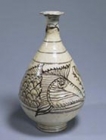Japanese Gallery (Honkan) Room 14
September 26, 2007 (Wed) - December 16, 2007 (Sun)
This display features the bold and lively art of Asian underglaze iron painting with works from various times and places.
Iron painting refers to underglaze designs painted in iron pigment. Using material that could be obtained easily, it started together with porcelain production in China and became one of the most widely and commonly used ceramic decoration methods. In particular, excellent works were produced at Cizhou kilns, where daily wares for common people were manufactured, during the Song (960-1279) and Yuan (1271-1368) dynasties.
The underglaze iron painting technique spread to other countries such as Korea, Vietnam, Thailand and Japan. In Korea, celadon glazed ware with underglaze iron painting was produced during the Goryeo dynasty (918-1392). Buncheong ware, covered with white slip and grayish blue glaze, with underglaze iron decoration from the Joseon dynasty (1392-1910) was known as Gyeryongsan ware. Underglaze iron painting was also applied to white porcelain. In Japan, the technique is called "sabi-e (rust painting)" and was used to decorate Shino and Oribe style wares among others.
Although iron painting is not as finely detailed as the underglaze blue design painted on white porcelain ware using cobalt pigment, it has unique charms such as quick and vigorous brushwork of the mass produced ware as well as humorous expressions of non-imperial kilns. It is also interesting to find unexpectedly common elements in works of different provenances.

